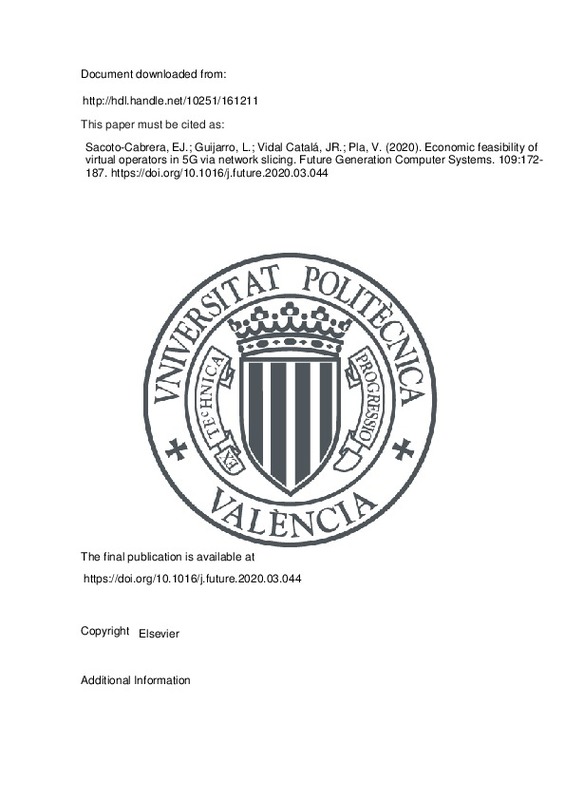JavaScript is disabled for your browser. Some features of this site may not work without it.
Buscar en RiuNet
Listar
Mi cuenta
Estadísticas
Ayuda RiuNet
Admin. UPV
Economic feasibility of virtual operators in 5G via network slicing
Mostrar el registro sencillo del ítem
Ficheros en el ítem
| dc.contributor.author | Sacoto-Cabrera, Erwin J.
|
es_ES |
| dc.contributor.author | Guijarro, Luis
|
es_ES |
| dc.contributor.author | Vidal Catalá, José Ramón
|
es_ES |
| dc.contributor.author | Pla, Vicent
|
es_ES |
| dc.date.accessioned | 2021-02-13T04:32:08Z | |
| dc.date.available | 2021-02-13T04:32:08Z | |
| dc.date.issued | 2020-08 | es_ES |
| dc.identifier.issn | 0167-739X | es_ES |
| dc.identifier.uri | http://hdl.handle.net/10251/161211 | |
| dc.description.abstract | [EN] The provision of services by more than one operator over a common network infrastructure, as enabled by 5G network slicing, is analyzed. Two business models to be implemented by a network operator, who owns the network, and a virtual operator, who does not, are proposed. In one business model, named strategic, the network operator provides service to its user base and the virtual operator provides service to its user base and pays a per-subscriber fee to the network operator. In the other business model, named monopolistic, the network operator provides service to both user bases. The two proposals are analyzed by means of a model that captures both system and economic features. As regards the systems features, the slicing of the network is modeled by means of a Discriminatory Processor Sharing queue. As regards the economic features, the incentives are modeled by means of the user utilities and the operators' revenues; and game theory is used to model the strategic interaction between the users' subscription decision and the operators' pricing decision. In both business models, it is shown that the network operator can be provided with the appropriate economic incentives so that it acquiesces in serving the virtual operator's user base (monopolistic model) and in allowing the virtual operator to provide service over the network operator's infrastructure (strategic model). From the point of view of the users, the strategic model results in a higher subscription rate than the monopolistic model. | es_ES |
| dc.description.sponsorship | This work has been supported by the Spanish Ministry of Science, Innovation and Universities (MCIU/AEI) and the European Union (FEDER/UE) through Grant PGC2018-094151-B-I00. And by the Salesian Polytechnic University of Ecuador through a Ph.D. scholarship granted to the first author. | es_ES |
| dc.language | Inglés | es_ES |
| dc.publisher | Elsevier | es_ES |
| dc.relation.ispartof | Future Generation Computer Systems | es_ES |
| dc.rights | Reserva de todos los derechos | es_ES |
| dc.subject | 5G | es_ES |
| dc.subject | Network slicing | es_ES |
| dc.subject | Virtual operators | es_ES |
| dc.subject | Discriminatory processor sharing | es_ES |
| dc.subject | Game theory | es_ES |
| dc.subject.classification | INGENIERIA TELEMATICA | es_ES |
| dc.title | Economic feasibility of virtual operators in 5G via network slicing | es_ES |
| dc.type | Artículo | es_ES |
| dc.identifier.doi | 10.1016/j.future.2020.03.044 | es_ES |
| dc.relation.projectID | info:eu-repo/grantAgreement/AEI/Plan Estatal de Investigación Científica y Técnica y de Innovación 2017-2020/PGC2018-094151-B-I00/ES/SLICING DINAMICO EN REDES DE ACCESO RADIO 5G/ | es_ES |
| dc.rights.accessRights | Abierto | es_ES |
| dc.contributor.affiliation | Universitat Politècnica de València. Departamento de Comunicaciones - Departament de Comunicacions | es_ES |
| dc.description.bibliographicCitation | Sacoto-Cabrera, EJ.; Guijarro, L.; Vidal Catalá, JR.; Pla, V. (2020). Economic feasibility of virtual operators in 5G via network slicing. Future Generation Computer Systems. 109:172-187. https://doi.org/10.1016/j.future.2020.03.044 | es_ES |
| dc.description.accrualMethod | S | es_ES |
| dc.relation.publisherversion | https://doi.org/10.1016/j.future.2020.03.044 | es_ES |
| dc.description.upvformatpinicio | 172 | es_ES |
| dc.description.upvformatpfin | 187 | es_ES |
| dc.type.version | info:eu-repo/semantics/publishedVersion | es_ES |
| dc.description.volume | 109 | es_ES |
| dc.relation.pasarela | S\407173 | es_ES |
| dc.contributor.funder | Agencia Estatal de Investigación | es_ES |
| dc.contributor.funder | European Regional Development Fund | es_ES |
| dc.contributor.funder | Universidad Politécnica Salesiana, Ecuador | es_ES |
| dc.description.references | NGMN Alliance, 5G white paper, Next Generation Mobile Networks, White paper, 2015. | es_ES |
| dc.description.references | Naor, P. (1969). The Regulation of Queue Size by Levying Tolls. Econometrica, 37(1), 15. doi:10.2307/1909200 | es_ES |
| dc.description.references | Allon, G., & Federgruen, A. (2008). Service Competition with General Queueing Facilities. Operations Research, 56(4), 827-849. doi:10.1287/opre.1080.0545 | es_ES |
| dc.description.references | Mandjes, M. (2003). Pricing strategies under heterogeneous service requirements. Computer Networks, 42(2), 231-249. doi:10.1016/s1389-1286(03)00191-9 | es_ES |
| dc.description.references | Sacoto-Cabrera, E. J., Sanchis-Cano, A., Guijarro, L., Vidal, J. R., & Pla, V. (2018). Strategic Interaction between Operators in the Context of Spectrum Sharing for 5G Networks. Wireless Communications and Mobile Computing, 2018, 1-10. doi:10.1155/2018/4308913 | es_ES |







![[Cerrado]](/themes/UPV/images/candado.png)

